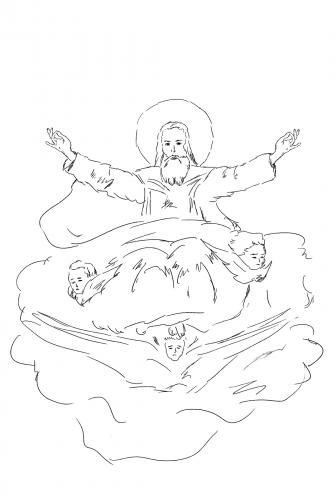



Sabaoth/Lord of Hosts
Sabaoth is one of the attributes of God in the Old Testament, being translated from Hebrew as the Lord of (Heavenly) Hosts, but it also means Almighty (Psalms, 45). In the first translations of the Old Testament in Greek, the attribute Sabaoth was understood as Pantokrator, such as in the Vision of Isaiah (Isaiah 6:1-2). The Lithurgy employs the same meaning in the words of the hymn "Holy, holy, holy, Lord God Almighty; heaven and earth are full of His glories!"
Iconographically, Sabaoth is represented either frontally or semiprofile, standing or three-quarters, surrounded by clouds. The character is depicted as if driving over the clouds, like in a chariot. In the Hebrew Bible exegesis, which influenced the Christian one, there is a huge literary corpus dedicated to the Throne of God, seen quite often as a Chariot, like in Ezekiel's vision (Ezekiel, 1). In most of the cases the moving clouds are supported by cherubs, but in more elaborate images the angelic order of Wheels is also present, another reference to Ezekiel's vision.
Sabaoth is represented with all the characteristic features of the iconographic theme God the Father (see canon God the Father), however there is a major difference as far as the character's gestures are concerned: the arms are raised above the head, in an ample act of blessing, while Sabaoth is looking down, towards the creation.
The iconography of the theme Sabaoth has been often mixed up with that of another theme - God the Father. There are representations of the second theme wrongfully bearing the inscription "Sabaoth".
Sabaoth is one of the attributes of God in the Old Testament, being translated from Hebrew as the Lord of (Heavenly) Hosts, but it also means Almighty (Psalms, 45). In the first translations of the Old Testament in Greek, the attribute Sabaoth was understood as Pantokrator, such as in the Vision of Isaiah (Isaiah 6:1-2). The Lithurgy employs the same meaning in the words of the hymn "Holy, holy, holy, Lord God Almighty; heaven and earth are full of His glories!"
Iconographically, Sabaoth is represented either frontally or semiprofile, standing or three-quarters, surrounded by clouds. The character is depicted as if driving over the clouds, like in a chariot. In the Hebrew Bible exegesis, which influenced the Christian one, there is a huge literary corpus dedicated to the Throne of God, seen quite often as a Chariot, like in Ezekiel's vision (Ezekiel, 1). In most of the cases the moving clouds are supported by cherubs, but in more elaborate images the angelic order of Wheels is also present, another reference to Ezekiel's vision.
Sabaoth is represented with all the characteristic features of the iconographic theme God the Father (see canon God the Father), however there is a major difference as far as the character's gestures are concerned: the arms are raised above the head, in an ample act of blessing, while Sabaoth is looking down, towards the creation.
The iconography of the theme Sabaoth has been often mixed up with that of another theme - God the Father. There are representations of the second theme wrongfully bearing the inscription "Sabaoth".




